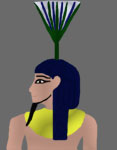

Nefertum (Nefertem, Nefertemu) was the god of the lotus blossom who emerged from the primeval waters at the beginning of time, and a god of perfume and aromatherapy. He may have originally been considered to be an aspect of Atum.
According to one version of the creation story of the Ennead in Heliopolis, Nefertum (translated as beautiful Atum, or perfect Atum) was born from a blue lotus bud which emerged from the waters of Nun at the beginning of creation.
Atum represented the sun and so Nefertum represented the sunrise. He cried because he was alone and his tears created humanity. It was thought that he was born with every sunrise, matured into Atum during the day before passing into the world of the dead every sunset. The cycle of birth in the morning and death every evening (as the sun travelled through the underworld) represented the daily struggle between Chaos and Order (Ma’at).

When Atum was absorbed by Ra (Atum-Ra), Nefertum came to be considered as a separate deity, still closely associated with the newborn sun. Then Ptah was promoted to the chief national god and proclaimed the ultimate creator, and Nefertum was described as his son by either Sekhmet or Bast (both “Daughters of Ra”). However, as the son of Ptah, he also became patron of the cosmetic and healing arts derived from flowers. Thus, Nefertum was seen as both an aspect of the sun god, and also his grandson.
He was most closely associated with the blue lotus, a flower with narcotic properties. According to one legend, Nefertum brought a bouquet of beautiful lotuses to the aging Ra to ease his suffering. As a result, he was described in the Pyramid Texts as “the lotus blossom which is before the nose of Re”.
Nefertem was linked both to the pleasant scent of the lotus flower and to its medical properties (which were well known to the ancient Egyptians). He was also associated with a number of the Egyptian’s favourite flowers, such as rose, geranium, and cornflower. In fact, he could be described as the archetypal aromatherapist.
He was also linked to rebirth, both as a personification of the newborn sun and as the patron of many of the necessary ingredients of the mummification process. A passage of the Book of the Dead says the blessed dead will “Rise like Nefertum from the lotus, to the nostrils of Ra, and come forth upon the horizon each day”.

Nefertum was usually depicted as a beautiful young man wearing a lotus headdress, sometimes standing on the back of a lion. He occasionally wears a headdress with two plumes and two necklace counterpoises which were symbols of fertility associated with Hathor (who in turn was closely associated with both of the goddesses described as his mother – Sekhmet and Bast).
He was sometimes depicted as a man with the head of a lion or as a reclining lion or cat. In this form he was associated with the lion god Maahes who may have been his brother, but may also have been an aspect of Nefertum. As the newborn sun he was generally depicted as a beautiful baby sitting in or on a lotus bud.
He was known as “He Who is Beautiful” and “Water Lily of the Sun” and was held in great affection. Egyptians often carried small statuettes of him as good-luck charms or protective amulets. Conversely, his leonine aspect could make him a force to be feared. During the Third Intermediate Period “divine decrees” were made when a child was born which aimed to protect them from the manifestations of Nefertum.
Bibliography
- Goodenough, Simon (1997) Egyptian Mythology
- Kemp, Barry J (1991) Ancient Egypt: Anatomy of a Civilisation
- Pinch, Geraldine (2002) Handbook Egyptian Mythology
- Watterson, Barbara (1996) Gods of Ancient Egypt
- Wilkinson, Richard H. (2003) The Complete Gods and Goddesses of Ancient Egypt
Copyright J Hill 2016